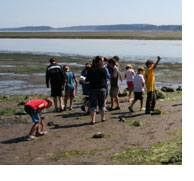
Get Involved with NRNC



ABOUT NRNC
 Map and Directions
Map and Directions Hours
Hours Parking
Parking Fundraising
FundraisingAQUATIC RESERVE
BECOME A MEMBER
VOLUNTEER
 Volunteer Calendar
Volunteer Calendar
WILDLIFE AT NRNC
 Birds
Birds Invertebrates
Invertebrates
RESEARCH
EDUCATION
PHOTOS
HOME
Nisqually Reach Nature Center
4949 D'Milluhr Dr. NE
Olympia WA 98516-2311
(360) 459-0387
NRNC@NisquallyEstuary.org

 |
|
| More Educational Programs | Application for Education Visit |
 |
|
EDUCATION
Inquiry-Based Science Programs
At NRNC, we realize that math and science skills in Washington state schools are dropping at an alarming rate. Test scores indicate that between the 8th and 10th grade, there is an average of a 29% drop in math and even higher percentage drop in science scores. At NRNC, our inquiry-based science programming was designed to align with Washington Essential Academic Learning Requirements (EALRs) and state-wide Grade Level Expectations (GLEs) and we have incorporated the following Science GLEs into our programs:(EALR 1-Systems) GLEs 1.1.6, 1.2.1, 1.2.3, 1.2.5, 1.2.6, 1.2.7, 1.3.6, 1.3.8, 1.3.10, all of (EALR 2-Inquiry), which is GLEs 2.1.1 through 2.2.5, as well as (EALR 3-Application) GLEs 3.1.1, 3.1.3, and 3.2.4.
All of the program content will be instructed to align with existing EALRs and state-wide Grade Level Expectations for science and math. Teachers will be surprised to see how effectively complex science concepts can be demonstrated and enforced through simple experiential exercises.
Students coming to the center will have the opportunity to conduct a variety of field investigations, such as: How to collect bivalves, shore crabs, plankton, and fish; proper identification of species; and in some cases, students will also measure species to learn growth dynamics.

Students will do repeat investigations for comparison, thereby really understanding what their data are saying and being able to interpret more out of it. They will have first-hand experience in nearshore estuarine investigations and be able to perform compare-and-contrast student surveys.
Students will enter their data into a database and be expected to use critical thinking skills to make informed conclusions about their data.
Students will also have a unique opportunity to see a large variety of species and be able to identify them in the center's unique system of five intertidal aquariums.
Students will get a chance to see from our center the adjacent Nisqually restoration site where they will:
See first-hand what a dike removal looks like and how it works.
Students will have an opportunity to see and identify various avian species that are using the restoration site and learn about why this is important ecologically.
Students will also learn about the history of the area and what led to the habitat modifications.
Students will understand the significance of estuarine restoration and the various ecological concepts connected to the largest restoration process in the Puget Sound.
Our programs are designed to engage students in critical thinking to ask pertinent questions and garner a better understanding of how math applies in processing results.

Crab Survey
The shore crab survey consists of collecting shore crabs within a 33cm2 quadrant. The shore crabs are sexed, counted, and measured. Photos will be taken of each species caught in order to further document diversity levels and/or to aid in identification. Multiple replicates are performed during each monitoring event. br />Bivalve Survey The bivalve survey consists of digging a hole in a mud habitat within a 33cm2 quadrant up to a depth of 33 cm. The mud will be sorted through and the bivalves placed in a collecting cup. The bivalves and any outliers found (such as ghost shrimp or worms) will be laid out for identification, counting, and measurement. Multiple replicates are performed during monitoring event.